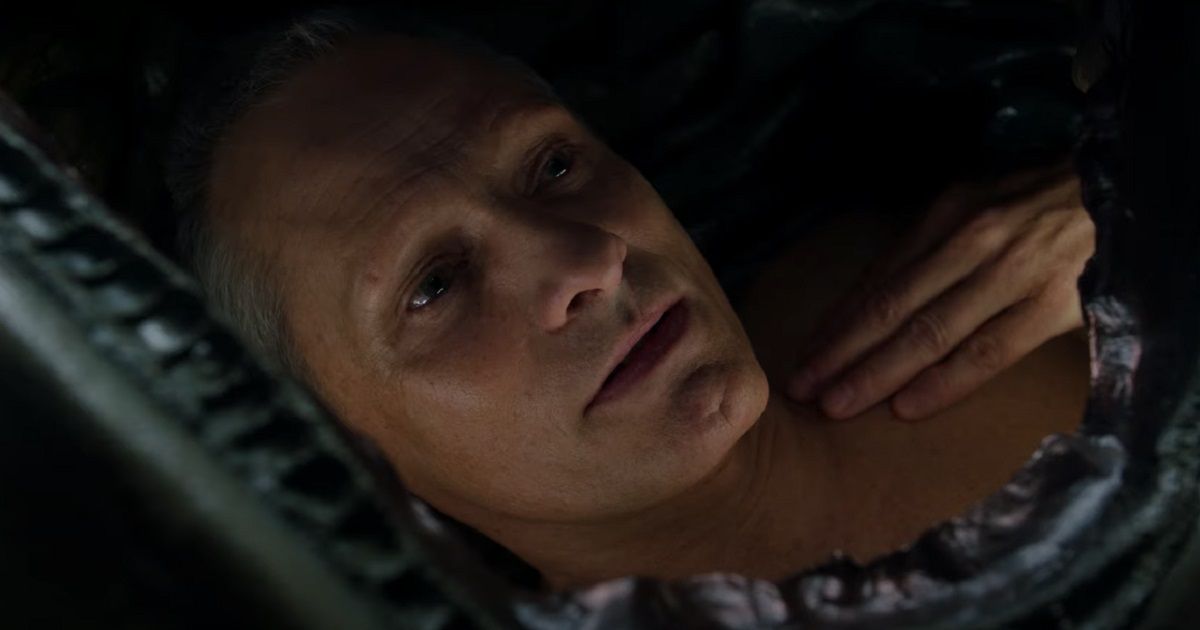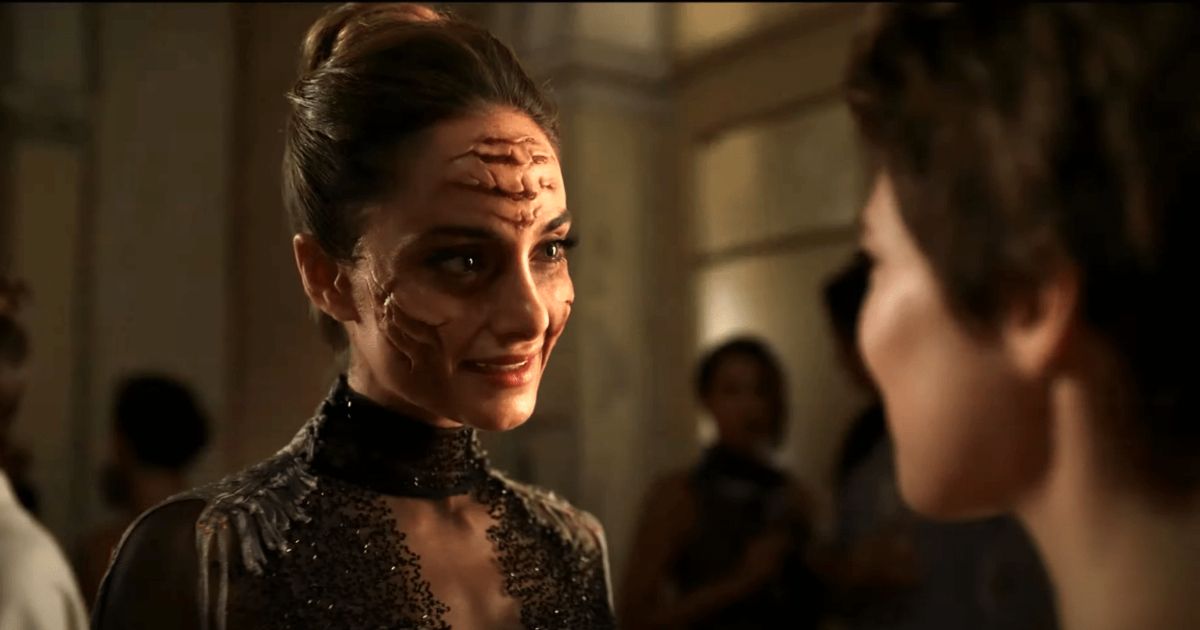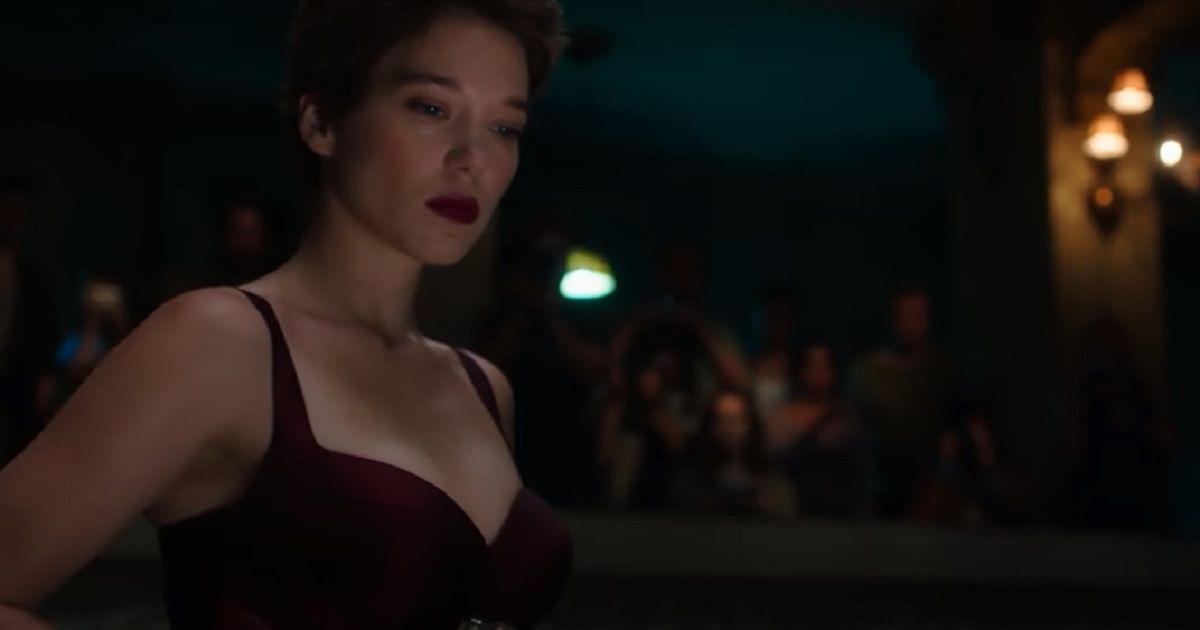#Dissecting David Cronenberg’s New Movie
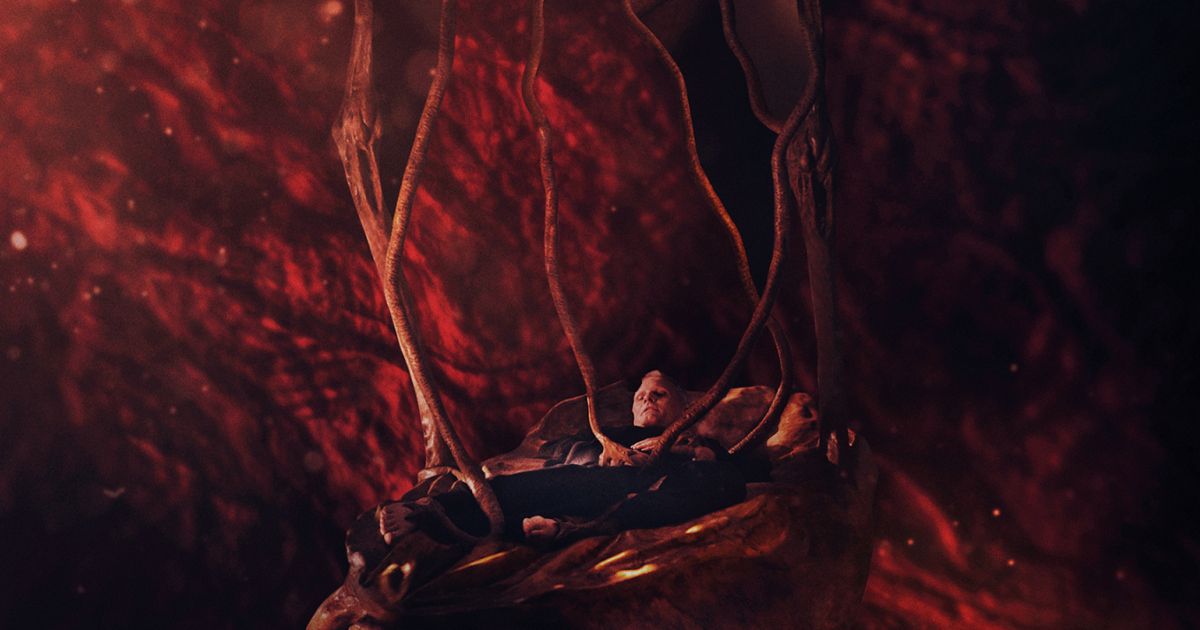
Table of Contents
“Dissecting David Cronenberg’s New Movie”
The film, starring Viggo Mortensen and Lea Seydoux as surgery-loving performance artists and Kristen Stewart as a post-apocalyptic fangirl, can certainly be divisive. Hardcore Cronenbergers (a neologism one may regret) are likely to love it; most people will find it to be too gruesome and odd (as evidenced by large amounts of walk-outs at Cannes). Both sides of the deserted aisle are likely to agree on one thing: it’s not an easy watch and, like many Kristen Stewart line readings, it doesn’t always make sense. But, as in every Cronenberg film, there is a method to the madness here (or at least something diagnosable). Take a look at some interpretations of Cronenberg’s new film, but by all means, see and experience it for yourself.
Crimes of the Future is About the Evolution of the Body
“Body is reality,” some cold text ironically displays on an outdated television. Has there ever been a more succinct thesis statement for a film?
Crimes of the Future opens in an appropriately shocking and disturbing way — a seemingly normal boy brushes his teeth and goes to spit in a trash can; except, he begins eating the plastic wastebasket, his mother watching in complacent horror but exuding the sense that this isn’t the first time. Later that night, the mother will smother her son to death with a pillow. Immediately, a major theme of the film is put on display: bodies doing things they aren’t supposed to be doing, why they’re doing it, and either the fascination or horror this evokes in others as a result.
Essentially, this is the name of the game for two performance artists in Crimes of the Future, Saul Tenser and Caprice, whose favorite instrument is the organ in their gutsy art show. Surgical puns aside (they’re all ‘in vein’ anyway), the ice-cold lovers use complicated medical equipment such as an autopsy machine to slice into Tenser and remove his organs in a bit of performance art that would make even Marina Abramović blush. This is because Tenser, like many ‘humans,’ is changing — he’s growing strange new organs at an exponential rate, in a period of human evolution in which the somatic sensation of pain and the vulnerability to infection has drastically decreased. When humanity gets less nociceptive, society gets more bizarre.
The government is threatened by the bizarre evolutionary changes taking place in the grim, ash-like society of Crimes of the Future, which makes 1984 look like Mardi Gras. There’s a bureaucratic institution called an ‘organ registry,’ which requires the registration of these mutations, and a governmental police force which seems to be investigating a group of radicals who put the ‘evolutionary’ in ‘revolutionary,’ and who believe their bodies are changing in a way which can allow for the consumption of plastic.
As such, Crimes of the Future is uniquely obsessed with the biological organism and the set of visceral processes known as ‘the human being.’ The film envisions a world in which the body is changing drastically (Accelerated Evolution Syndrome, as it’s called here), and asks us to consider what it means to be human within the fluidity of evolution.
Crimes of the Future is About the Technology of the Self
What it means to be human, as Crimes of the Future and Cronenberg postulate, is intricately tied up with the technology of the species. In a delightful interview for the Canadian radio show q, Cronenberg went into a soulful soliloquy about the film and his work in general:
The body, for me, is the essence of human existence. It is what we are, and everything comes from that, including technology. In the 1950s, technology was this inhuman stuff from outer space that threatened us, you know, strange weapons and stuff like that. For me, technology has always been ultra-human and a complete extension of what we are. Our fists become, you know, missiles […] So technology also becomes what we are, for the good and the bad. And you see it with every new technology. You see the internet, you see social media. It’s wonderful, and it’s horrible, horrible and horrifying. At the same time, it brings out the worst of us, and also the best. So to me, it’s just natural to go there. I’m diving into the essence of what we are and the essence of the human condition, and [Crimes of the Future] takes me there.
Technology is thus an extension of biology, and in the shiny, polished reflection of a society’s tools, you can see its citizens. The sleek, weird contraptions of Crimes of the Future help people eat, sleep, reach orgasm, and experience pleasure in ways not unlike our own dog days of digital summer. In the film, machines slice the human body to create pleasure, while in reality, people swipe right on different machines they rely upon.
Like dogs, technology evolves alongside the human species. Unlike dogs (hopefully), it seems to affect the evolution of human biology almost in a symbiotic way. The technology in Crimes of the Future often does what the characters themselves cannot, just as the convenience of technology leads to the obsolescence of certain mental capacities. Try remembering numerous phone numbers now that you can save them in your contacts; in 20 years, try remembering anything, now that you can Google it at any given moment. “The production of too many useful things results in too many useless people,” Karl Marx said
In a very important sense, the Accelerated Evolution Syndrome in Crimes of the Future is a result of humanity’s industrial technology. Organs are trying to keep up with the pace of technology and the effects of pollution, toxicity, and ecological catastrophes, because evolution is ultimately about survival, and the body will change to survive the technologies we’ve created that pollute it.
Crimes of the Future is About Ecological and Climate Collapse
The very first scenes of Crimes of the Future explain a lot about the veins coursing through this film, if you watch them ‘varicosely.’ The opening image is of a capsized ship, a corroded vessel rusting through incessant tides. The film is apocalyptic in obvious ways, and the corrosion of industrial objects like this boat and practically every building speak to the notion of a careless species indifferent to its surroundings (or anything that isn’t the body). There are no cars in this world, no phones or internet to speak of, and there don’t seem to be any animals either; this is a chronicle of collapse, but one which takes place after the fall, in which newly evolved humans have managed to outlive their own destruction.
After the shipwrecked images, Crimes of the Future delivers its first plastic-munching moment, something which (aside from symbolic connotations with ‘plastic’ surgery) is key to the movie’s eco-horror themes. The synthetic-slurping murdered child in the beginning of the film is important, because it appears that his organs have allowed him to eat plastic. His father is leading the revolutionary evolutionists, who are creating plastic candy bars (with a Willy Wonka purple that seems like the only bright substance in this nickel-colored world) for people to subsist on; they’re toxic if your body hasn’t evolved in the right way or had the surgery required to adapt.
In one of the (thankfully) rare instances of child autopsy in Tinseltown, the father hopes to show the world that humanity can evolve to eat plastic and survive this apocalypse in an ‘organ-ized’ way. The government, rather nefariously, is concerned about this; in Crimes of the Future, evolution, technology, and biology are inherently connected to (and a concern of) politics.
Perhaps, in its own artistically sick and depraved way, Crimes of the Future is an optimistic love letter to the future, one where humanity overcomes what it’s done to itself. After all, humanity is destroying the planet and themselves in a variety of ways, one of which is with plastic. As of 2016, there’s been over nine billion tons of plastic produced since 1950, enough to bury Manhattan under two miles of garbage.
“At the current rate, we are really heading toward a plastic planet,” the industrial ecologist Roland Geyer says in a CTV article. “At some point we will run out of room to put it,” Chelsea Rochman, a professor of ecology at the University of Toronto, said in the same article. “Some may argue we already have and now it’s found in every nook and cranny of our oceans.” Maybe humanity can take one for the team and start eating it, like in Crimes of the Future.
Eventually, the human body might have to. Microplastics are being discovered in everything, from rice to tap water, shellfish to sardines, and in 2018 considerable amounts were found in human feces for the first time. Plastic is showing up in children’s blood and in human placenta, which was gross enough to begin with. Perhaps the real Crimes of the Future are what we’re doing to the planet, something which is actually being pushed by legal experts to be considered as an international crime against humanity.
When Tenser eats plastic at the end of the film, he sheds a tear, a rare instance of emotion in this chilly world. Maybe he’s overjoyed that he can finally consume something without pain and that the body has evolved to consume plastic; or perhaps he’s overcome with sadness that this is what we are reduced to. Crimes of the Future depicts the body’s adjustment to the damages caused by our own technologies, and in this sense, perhaps Cronenberg is right to call it “body beautiful” rather than “body horror.”
Crimes of the Future is About Artists Like David Cronenberg
Crimes of the Future often seems to be Cronenberg’s artistic way to work out these themes; in a much less sociopolitical sense, the film is about art itself, especially Cronenberg’s. More than half a century before this film, David Cronenberg’s second movie (after the experimental short Stereo) was released. The 1970 film concerns a so-called “house of skin,” a “residential clinic for wealthy patients who were treated for extremely pathological skin conditions induced by contemporary cosmetics,” as the narrator says. This 1970 picture is titled Crimes of the Future.
To possibly be reductive for a moment, it could be said that Cronenberg has come full-circle as an artist. From his experimental beginnings, to the schlock horror of the ’70s and his wild body horror films of the ’80s, his cold intellectual experiments in the ’90s and his more dramatic and much less gory films of the 2000s, the evolutionary progression of the director has slowly begun to eat its own tail with the ouroboros that is Crimes of the Future. Essentially his first ‘body horror’ film since 1999’s masterpiece eXistenZ, this new film graphically allegorizes what Cronenberg has been doing all along — opening himself up.
It’s hard to mistake the metaphor in Crimes of the Future of a performance artist (played by someone who has worked with the director four times now) literally dissecting himself for his art, and showing off his gory viscera as provocative entertainment. The idea of growing new organs is tantamount to developing new projects, and the people he works with (the organ registry, like a production studio, or his partner and the machinery, like a cast and crew) have an artistic dedication to bring these projects into realization. Even Kristen Stewart’s incredibly awkward (and somehow awkwardly incredible) performance, alongside the slew of gawking spectators and adorers, indicates a destructive and ruinous fan culture. For each organ, a film.
Crimes of the Future is Not About Anything
The title of one of Susan Sontag’s greatest books (and essays), Against Interpretation, speaks to something often ignored on the internet or in fan culture: nothing needs to mean anything. When being interviewed about his swan song Inland Empire for The New Yorker, David Lynch said, “As soon as you put things in words, no one ever sees the film the same way. And that’s what I hate, you know. Talking — it’s real dangerous.”
With that said, it’s perfectly okay to not understand a minute of Crimes of the Future. Its plot is abstract and its world-building vague, its themes obscure and its characters opaque. Unlike teenagers, it does not cry out to be understood. Like food poisoning, it gives the viewer a gut feeling — flight or fight, run away and never watch this horrifying offal or sit with the masterpiece and confront the enigma. If you stick around long enough to get sucked into its dark and otherworldly atmosphere, it is truly an experience, even if you don’t understand a lick of it. Crimes of the Future is a feeling, an unsettling gesture, part nightmare, part techno-prophecy, and 100% Cronenberg.
If you liked the article, do not forget to share it with your friends. Follow us on Google News too, click on the star and choose us from your favorites.
For forums sites go to Forum.BuradaBiliyorum.Com
If you want to read more Like this articles, you can visit our Social Media category.
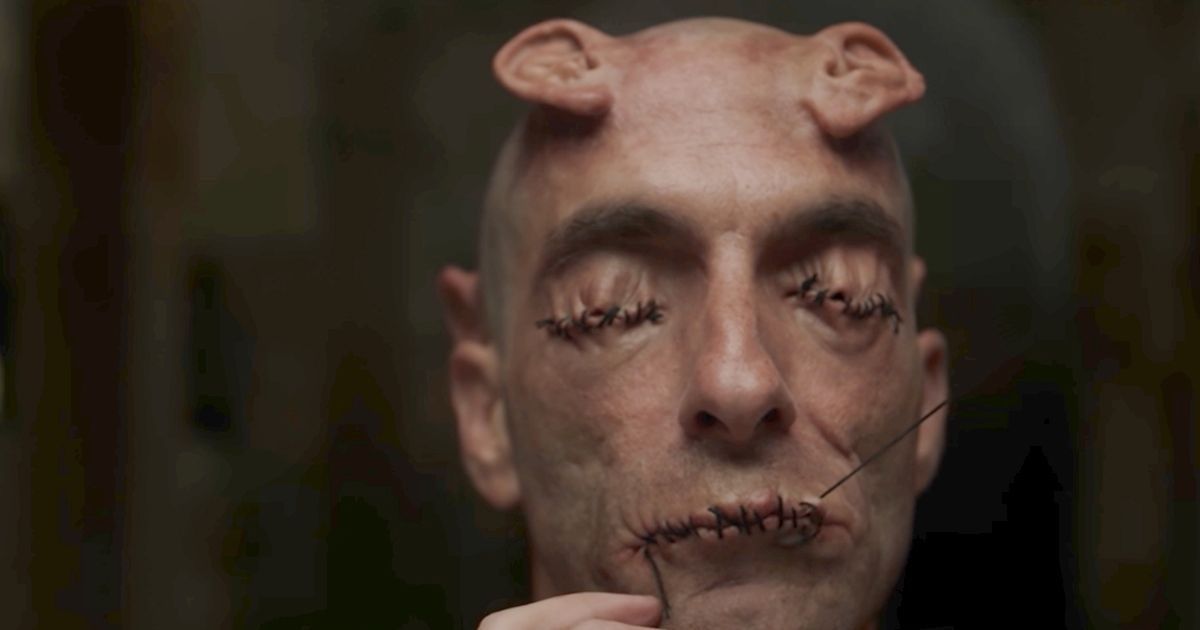
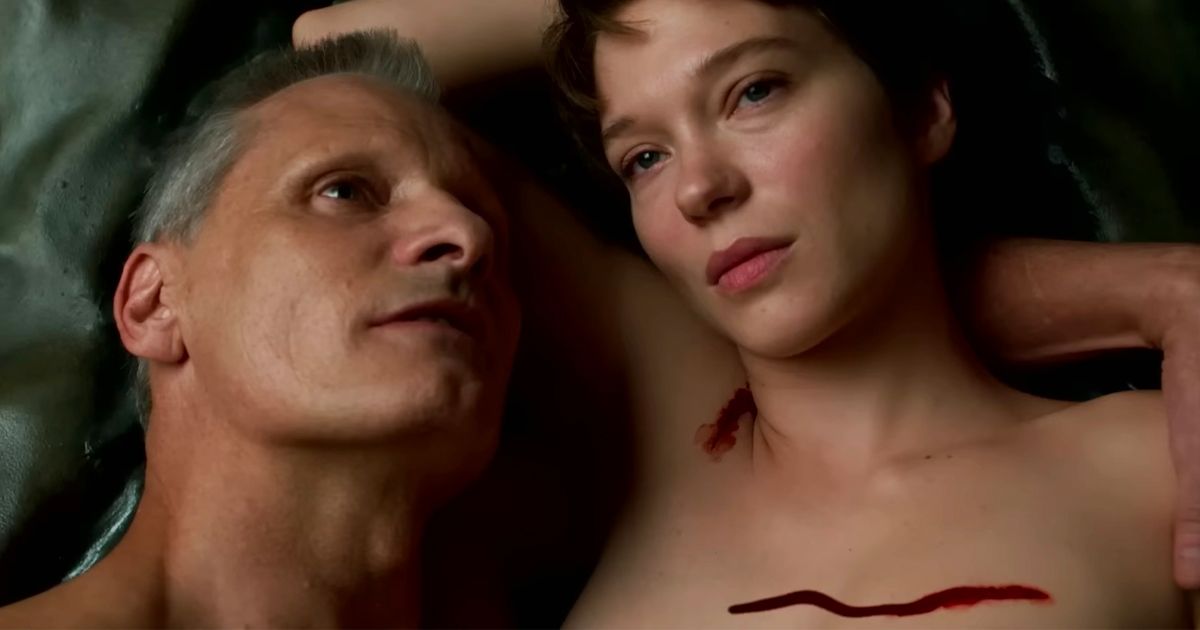

.jpg)
